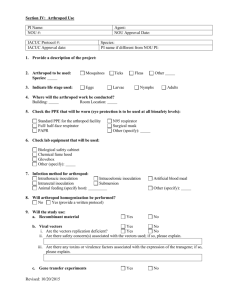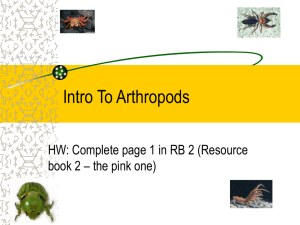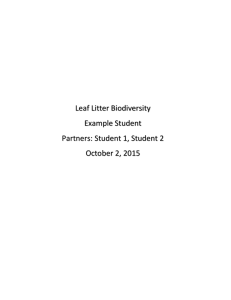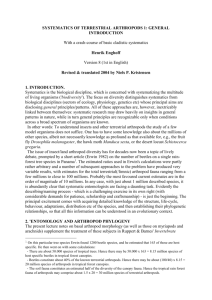Responsibilities of the intern
advertisement
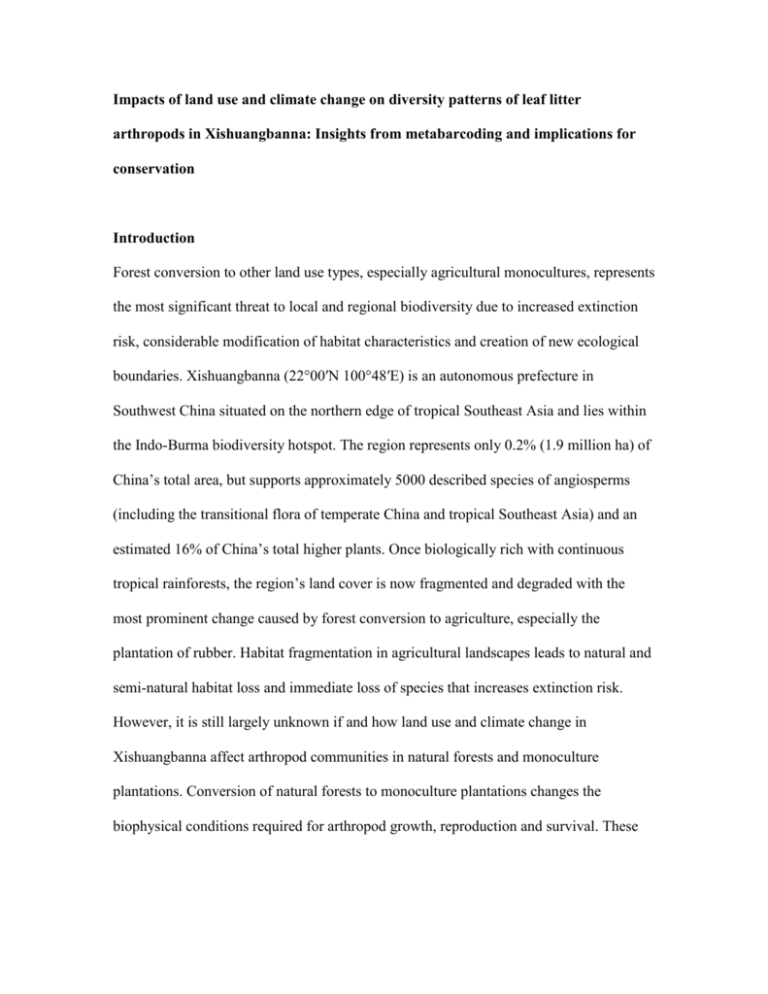
Impacts of land use and climate change on diversity patterns of leaf litter arthropods in Xishuangbanna: Insights from metabarcoding and implications for conservation Introduction Forest conversion to other land use types, especially agricultural monocultures, represents the most significant threat to local and regional biodiversity due to increased extinction risk, considerable modification of habitat characteristics and creation of new ecological boundaries. Xishuangbanna (22°00′N 100°48′E) is an autonomous prefecture in Southwest China situated on the northern edge of tropical Southeast Asia and lies within the Indo-Burma biodiversity hotspot. The region represents only 0.2% (1.9 million ha) of China’s total area, but supports approximately 5000 described species of angiosperms (including the transitional flora of temperate China and tropical Southeast Asia) and an estimated 16% of China’s total higher plants. Once biologically rich with continuous tropical rainforests, the region’s land cover is now fragmented and degraded with the most prominent change caused by forest conversion to agriculture, especially the plantation of rubber. Habitat fragmentation in agricultural landscapes leads to natural and semi-natural habitat loss and immediate loss of species that increases extinction risk. However, it is still largely unknown if and how land use and climate change in Xishuangbanna affect arthropod communities in natural forests and monoculture plantations. Conversion of natural forests to monoculture plantations changes the biophysical conditions required for arthropod growth, reproduction and survival. These changes have negative consequences on arthropod diversity and composition and result in increased extinction risk. Specific objectives • To project the effects of land use change on leaf litter arthropod diversity and community composition • To measure the conservation value of natural forests versus monoculture (rubber & tea) plantations • To determine the management treatments that are most successful in restoring endangered tropical ecosystems and maintaining high arthropod biodiversity • To evaluate the minimum patch size of natural forests required to sustain maximum arthropod biodiversity General hypotheses 1. Conversion of natural forests to monoculture plantations would result in loss of arthropod species. 2. The loss of arthropod species is expected to be related to • biophysical factors (e.g. vegetation structure, microclimate, litter characteristics) • management practices (e.g. fertilizer application, pest control, cutting of understory vegetation) Materials and methods Arthropod sampling Leaf litter arthropods will be collected from 5 paired sites in Menglun on a monthly basis for 12 months (Jan – Dec 2014) and from 30 paired sites across Xishuangbanna in June and July 2014. The study sites chosen include; natural forests (henceforth Forest), rubber plantations (henceforth Rubber) and tea plantations (henceforth Tea). In each site, nine leaf litter samples separated 10 m apart (1 in the middle and 2 each in the north, east, west and south directions) for Winkler will be obtained by placing 1 x 1 m PVC frames on the Forest, Rubber or Tea floor. The leaf litter and loose humus from within the frame area will be collected into a litter reducer (without disturbing the top soil) and sieved through a 0.6 x 0.6 mm mesh wire to separate arthropods from larger leaf litter materials. The resulting siftate (arthropods plus leaf and soil debris) will be transported to the laboratory in small polythene bags, where they will be transferred into coarse-mesh bags. The coarse-mesh bags will be subsequently suspended inside Winkler bags suspended over a collecting bottle containing 95% alcohol. The Winkler bags will be left to dry for 3 days (72 hours) at room temperature and pressure. Sample processing and data analysis Traditional methods of measuring and assessing arthropod community composition and diversity are time consuming, unreliable and require high expertise. Metabarcoding represents a powerful tool for biodiversity conservation and ecosystem management at the organismal to community level because it is more comprehensive, faster, reliable, and less dependent on taxonomic expertise. It is a fast biodiversity monitoring approach that integrates DNA taxonomy and high throughput DNA sequencing. This project takes advantage of robust, established arthropod sampling methodologies in addition to implementing recent high-throughput technologies using short DNA sequences to distinguish and assign taxonomies to individual arthropod species. Emerging technologies including DNA extraction, PCR amplification and pyrosequencing will be used to prepare samples, extract, amplify, and purify DNA, and post quality control of sequences. In order to denoise and cluster the sequences into Operational Taxonomic Units (OTUs), we will apply existing experimentally validated methods. Responsibilities of the intern 1. Sample collection: S/He might assist with leaf litter arthropod collection from the field sites around Xishuangbanna (Optional). 2. Arthropod sorting: During the 72 hrs of Winkler incubation, arthropods, some leaf litter and soil debris fall into the collecting bottle. S/He will be required to assist with sorting arthropods from the remaining debris (leaf litter and soil). It takes a day or less to sort a single sample (one site) usually. 3. Arthropod photographing: Since we’re not immediately interested in the identity of each arthropod species, because we’re going to DNA barcode (COI gene) them anyway, s/he will assist in taking photographs of all the arthropods in a sample. 4. DNA extraction: The photographed arthropods (from each site) will be crushed together and their DNA extracted. S/He will assist with DNA extraction from mass arthropod samples. 5. DNA amplification: S/He will assist with running the polymerase chain reaction (PCR), a biochemical technology in molecular biology to amplify a single or a few copies of a piece of DNA across several orders of magnitude, generating thousands to millions of copies of a particular DNA sequence. Note: All equipment required in each of the 5 sections mentioned above are available in our molecular lab or the XTBG Biogeochemical Lab. The intern is not obliged to use his/her personal equipment in the project during the internship.
